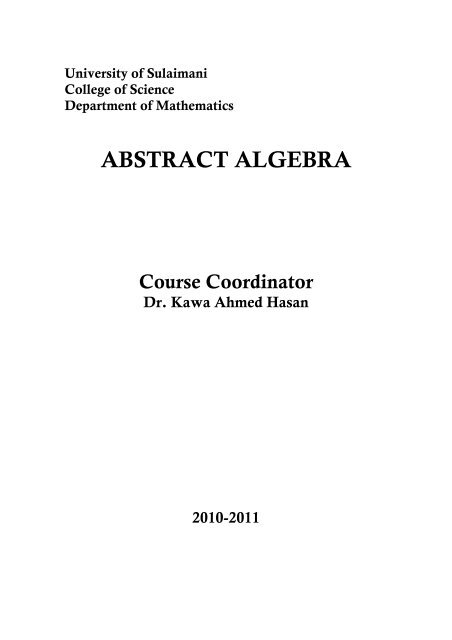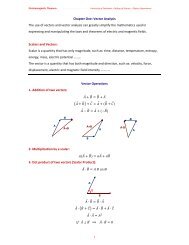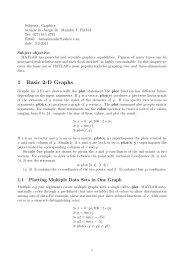ABSTRACT ALGEBRA - University of Sulaimani
ABSTRACT ALGEBRA - University of Sulaimani
ABSTRACT ALGEBRA - University of Sulaimani
You also want an ePaper? Increase the reach of your titles
YUMPU automatically turns print PDFs into web optimized ePapers that Google loves.
<strong>University</strong> <strong>of</strong> <strong>Sulaimani</strong><br />
College <strong>of</strong> Science<br />
Department <strong>of</strong> Mathematics<br />
<strong>ABSTRACT</strong> <strong>ALGEBRA</strong><br />
Course Coordinator<br />
Dr. Kawa Ahmed Hasan<br />
2010-2011
@<br />
‘ŠŽíØ@ðØímŠóq<br />
óØóŠŽíØ@ðäbØbníàbà@ïÜ@ì@‘‹qŠói@ñbnŽíàbà@<br />
Course Coordinator and the list <strong>of</strong> teachers on<br />
this course@<br />
@@<br />
@@Abstract Algebra @@@@@@@@Z‘ŠŽíØ@õìbä<br />
@@<br />
@@Z‘‹qŠói@ñbnŽíàbà<br />
@@Assistant Pr<strong>of</strong>essor Dr. Adil Kadir Jabbar<br />
@@<br />
@@Z@wïÜŽíØ@O@•ói@ðäb“ïä@ìbä<br />
@@Department <strong>of</strong> Mathematics-College <strong>of</strong> Science<br />
@@<br />
@@Z@‘‹q@Šói@ñbníàbà@ói@熋Ø@ñ‡äòíîóq<br />
@@HDr. Kawa Ahmed HasanI<br />
E-mail@Z@ðäŽìÙÝï÷@ñ‡îŠói<br />
@@adilkj@gmail.com<br />
kawa79b@gmail.com<br />
@@<br />
@@<br />
@@@
óØóŠŽíØ@ñóbåŽïq@ì@ðØó“Žïq<br />
Course Overview<br />
Abstract Algebra is one <strong>of</strong> the important subjects in mathematics it<br />
consists <strong>of</strong> three parts Group Theory, Ring Theory and Field Theory.<br />
The present course deals only with the Group Theory and Ring Theory.<br />
@@Part I : Group Theory<br />
The concept <strong>of</strong> the group has been introduced for the first time in<br />
1770 and extends to the twentieth century, but the major developments<br />
occurred in nineteenth century. This part will outline the origins <strong>of</strong> the<br />
main concepts, results, and theories discussed in a first course on group<br />
theory, for example, the concepts <strong>of</strong> abstract groups, normal subgroups,<br />
quotient groups, simple groups, free groups, isomorphisms,<br />
homomorphisms, automorphisms, composition series, direct products,<br />
the theorems <strong>of</strong> Lagrange, Cauchy, Cayley, Jordan-Holder, the theories<br />
<strong>of</strong> permutation groups and <strong>of</strong> abelian (commutative) groups. There are<br />
four major sources in the evolution <strong>of</strong> group theory, they are:<br />
1. Classical Algebra (Lagrange, 1770):<br />
Lagrange wrote his fundamental memoir " Reflections on the<br />
solution <strong>of</strong> algebraic equations" concerned polynomial<br />
equations. There were<br />
(i) Theoretical questions: dealing with the existence and nature <strong>of</strong><br />
the roots, for example, does every equation have a root ? how<br />
many roots are there ? are they real, complex, positive, negative ?<br />
(ii) Practical questions: dealing with methods for finding the roots.<br />
In the later, there were exact methods and approximate methods.<br />
2. Number Theory (Gauss, 1801):<br />
Gauss summarized and unified much <strong>of</strong> the number theory that<br />
preceded him. The work also suggested new directions which kipped<br />
mathematician occupied for the entire century. The groups appeared<br />
in four different guises : the additive group <strong>of</strong> integers modulo n ,<br />
that denoted by Z n , the multiplicative group <strong>of</strong> integers relatively<br />
prime to n , modulo n , the group <strong>of</strong> equivalence classes <strong>of</strong> binary<br />
quadratic forms, and the group <strong>of</strong> n − th roots <strong>of</strong> unity.<br />
3. Geometry (Klein, 1874):<br />
Klein has classified geometry as the study <strong>of</strong> invariants under<br />
various groups <strong>of</strong> transformations. Here there appear groups such
as the projective group, the group <strong>of</strong> rigid motions, the group <strong>of</strong><br />
similarities, the hyperbolic group, the elliptic group as well as the<br />
geometries associated with them.<br />
4. Analysis (Lie, 1874 ; Poincare and Klein, 1876):<br />
In 1874, Lie introduced his general theory <strong>of</strong> continuous<br />
transformation groups- essentially what we call Lie groups today,<br />
while Poincare and Klein began their work on " Automorphic<br />
functions " and the groups associated with them around 1876.<br />
Automorphic functions (which are generalizations <strong>of</strong> he circular,<br />
hyperbolic, elliptic, and other functions <strong>of</strong> elementary analysis)<br />
are functions <strong>of</strong> a complex variable z and there is a very famous<br />
group which is referred to Klein as a Klein 4- group.<br />
@@Part II : Ring Theory<br />
Among the most important examples <strong>of</strong> rings are the integers,<br />
polynomials, and matrices. Simple extensions <strong>of</strong> these examples are at<br />
the roots <strong>of</strong> ring theory and thus we have the following three examples:<br />
1. The integers Z can be thought <strong>of</strong> as the appropriate subdomain <strong>of</strong><br />
the field Q <strong>of</strong> rational numbers in which to do number theory.<br />
2. The polynomial rings R [x]<br />
and R [ x,<br />
y]<br />
in one and two variables,<br />
where R denotes the real numbers. In particular, while the roots <strong>of</strong> a<br />
polynomial in one variable constitute <strong>of</strong> discrete set <strong>of</strong> real numbers,<br />
the roots <strong>of</strong> a polynomial in two variables constitute <strong>of</strong> a curve in the<br />
plane a so-called algebraic curve.<br />
3. Square n × n matrices over the real numbers, can be viewed as n 2 -<br />
tuples <strong>of</strong> real numbers with coordinate wise addition and<br />
appropriate multiplication obeying the axioms <strong>of</strong> a ring. Our third<br />
n<br />
example consists <strong>of</strong> n − tuples R <strong>of</strong> real numbers with coordinate<br />
wise addition and appropriate multiplication, so that the resulting<br />
system is a (not necessarily commutative) ring. Such systems, <strong>of</strong>ten<br />
extensions <strong>of</strong> the complex numbers.
óØóŠŽ@íØ@ð−bàb÷@<br />
Course Objectives<br />
The main aims <strong>of</strong> the present course are:<br />
1. To introduce the basic concepts <strong>of</strong> group theory and ring theory to<br />
the students and illustrate these concepts by examples.<br />
2. To give the ideas on the nature <strong>of</strong> some problems in group theory<br />
and ring theory and then giving the methods by which one can prove<br />
those problems.<br />
3. The concept <strong>of</strong> a group can be used to explain some geometrical and<br />
physical phenomena, so that there are so many applications <strong>of</strong> group<br />
theory in physics and chemistry and for this reason this subject is<br />
also necessary for physics and chemistry students.<br />
4. Ring theory has been constructed as a trial to abstract some known<br />
properties <strong>of</strong> integers and algebraic numbers, so that these numbers<br />
were (till to now) an important and a suitable area to the ideas on<br />
which the developments <strong>of</strong> ring theory are based.<br />
5. The first part <strong>of</strong> this course consists <strong>of</strong> five chapters. In the first<br />
chapter <strong>of</strong> this course the groups and subgroups are defined and so<br />
many examples <strong>of</strong> them are given to make students so much familiar<br />
with the nature <strong>of</strong> groups. The second chapter deals with some<br />
special types <strong>of</strong> groups and subgroups such as, cyclic groups, simple<br />
groups, symmetric group S n , abelian groups, normal subgroups, the<br />
center <strong>of</strong> the groups, the alternating group A n and the quotient<br />
groups. The third chapter is devoted to study the properties <strong>of</strong><br />
groups and the ability <strong>of</strong> transferring these properties from a group<br />
to an other by a mapping which is known as a group<br />
homomorphism and at the end <strong>of</strong> this chapter some classical<br />
isomorphism theorems are given by which we can determine those<br />
groups which are isomorphic, so that they have exactly the same<br />
algebraic properties. In chapter four, we have presented prime<br />
groups and sylow p − groups and the sylow theorems are given<br />
which help us to know whether a finite group is simple or not and<br />
several examples <strong>of</strong> simple groups at the end <strong>of</strong> this chapter are<br />
given. The last chapter <strong>of</strong> this part deals with indecomposable and<br />
solvable groups. In fact, the concept <strong>of</strong> solvable groups gave the<br />
whole answer to a very old question which is: can we solve every<br />
equation
<strong>of</strong> degree n , for n ≥ 5, by radicals ?.<br />
6. The second part <strong>of</strong> this subject consists <strong>of</strong> eight chapters. In chapter<br />
six and chapter seven we gave the definitions <strong>of</strong> rings, subrings and<br />
ideals and supported with examples. Also, some types <strong>of</strong> rings and<br />
subrings are introduced such as, the center <strong>of</strong> a ring, maximal ideals,<br />
prime ideals, primary and semiprimary ideals and the relationships<br />
between these types <strong>of</strong> ideals are determined and the quotient rings,<br />
ring homomorphisms are studied in chapter eight and at the end <strong>of</strong><br />
this chapter the concept <strong>of</strong> embedding <strong>of</strong> rings are introduced.<br />
Euclidean domains, principal ideal domains, unique factorization<br />
domains, prime elements and irreducible elements all are studied in<br />
chapter nine and chapter ten and some relations between these<br />
integral domains are obtained. In chapter eleven, we defined and<br />
studied polynomial rings and the relations between this type <strong>of</strong> rings<br />
with Euclidean domains, principal ideal domains and unique<br />
factorization domains are determined. Also, irreducible and<br />
primitive polynomials are studied. In chapter twelve, Noetherian<br />
and Artinian rings are studied and the relations between them are<br />
given. The last chapter was devoted for defining the nil radical <strong>of</strong><br />
ideals and some results are proved.
A List <strong>of</strong> Some References:<br />
[1] S. Singh & Qazi Zameeruddin : ” Modern Algebra ” Vikas<br />
Publishing House ( 1972).<br />
[2] V. K. Khanna & S.K.Bhambri : ” A Course in Abstract<br />
Algebra ” Vikas Publishing House (2004).<br />
[3] H. A. Nielsen : ” Elementary Commutative Algebra ”<br />
Department <strong>of</strong> Mathematical Sciences-<strong>University</strong> <strong>of</strong> Aarhus<br />
(2005).<br />
[4] P. Garrett : ”Abstract Algebra-Lectures and Worked Examples<br />
for a Gradate Course ” (2005).<br />
[5] A. Hermann : ” Abstract Algebra ” (2004).

















